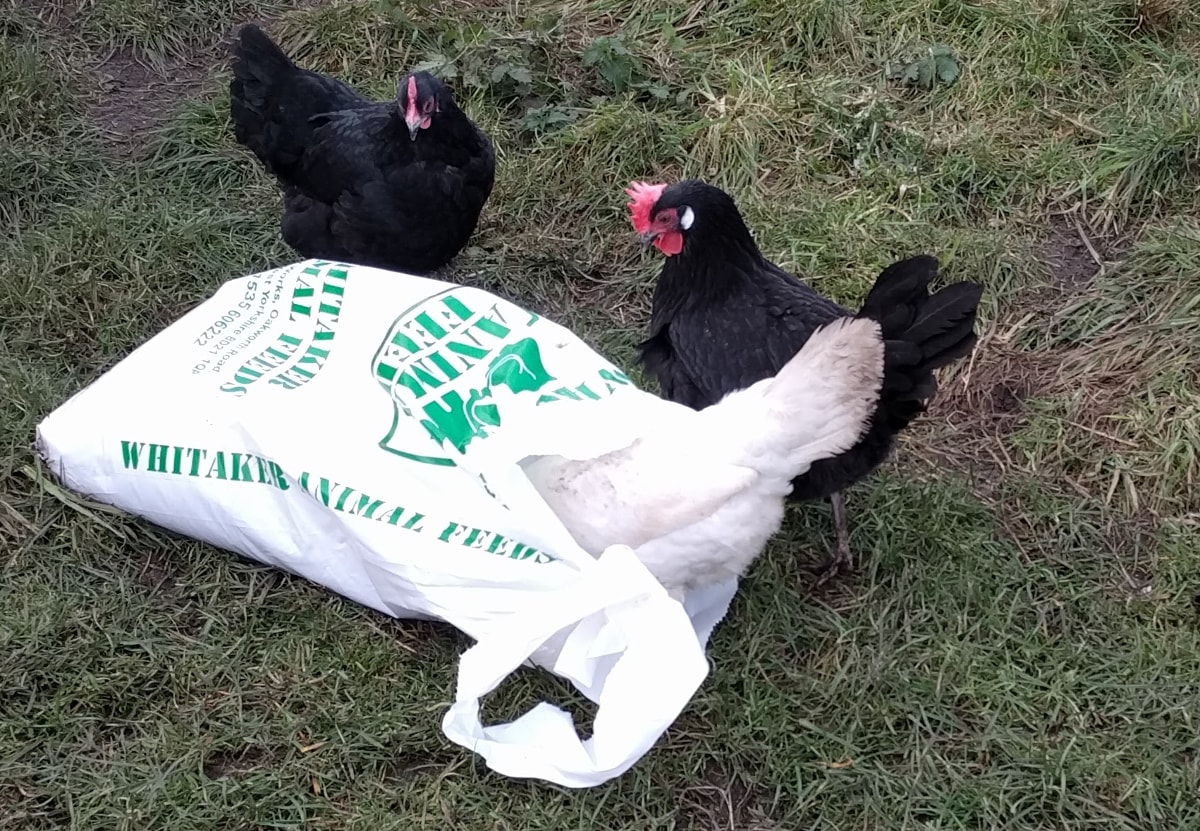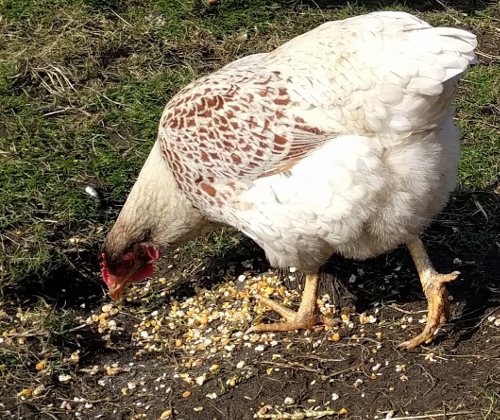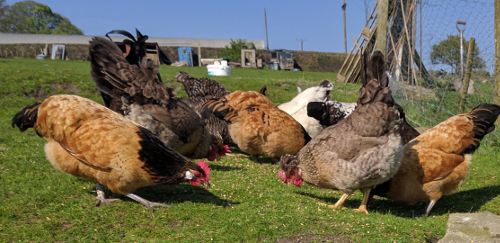How much do you feed to chickens

You can see from the picture above chickens won't hesitate to help themselves to what ever look like food. Above is a white star almost completely inside the feed bag. I am trying to work out if the two black Andalusian hens are jealous or looking down their beaks at her.
Table of Contents
- How much food does a hen need?
- How many eggs does a chicken produce per pound or kilogram of feed?
- Can you overfeed chickens?
- Can you underfeed chickens?
- How much to feed free range chickens:
- How much feed do cockerels need?
- What should I feed my chickens?
- Can chickens eat too much grain?
- Do chickens stop eating when they are full?
- How many times a day should I feed my chickens?
- Do I need to feed my chickens at all?
- How much feed for meat chickens or broilers:
- How much greens do chickens need?
- How much kitchen scraps can chickens have?
- Snails, worms and Insects as food for Chickens:
Modern, commercial high-production egg breeds have been selectively bred over many years to convert food to eggs or meat very efficiently and for this they need a good quantity of a quality ration specially made for laying hens.
Laying chickens are often quite light in weight and of fairly average size, after all body weight is metabolically costly to maintain and meat chickens are fast growing and put on weight quickly.
How much food does a hen need?
Chickens will eat when they need it and should go to bed with a full crop as they need lots of food to produce eggs. A fully grown chicken will typically eat about 120 grams of layers pellets a day.
Remember that it ate less when it was small, and the amount of feed consumed increased each week. A medium-weight laying hen will eat about 1/4 pound of feed per day when she begins producing.
How much to feed your chickens table:
| Chicken Type: | Grams / Ounces feed per bird per day: |
| Day old chicks | 14 g / 0.5 ounces |
| Week old chicks | 19 g / 0.75 ounces |
| 7 week old growers | 50 g / 2 ounces |
| 17 weeks POL | 90 / 3.2 ounces |
| 24 weeks + Maintenance | 195 g / 7 ounces |
Figures given are averages. Bantams will be less by about half depending on the breed and rare breeds may be 10% to 15% more because of their heavier body weight.
Below: One of my Barnevelder flock eating mixed seed feed.

The one thing I heave learned from keeping hundred of types of chickens for over 20 years is that they like variety in their feed.
Chickens need a balanced diet that contains:
- Protein, for growth, new cells and eggs.
- Carbohydrate, Energy to power everyday scratching.
- Fats, some fats are essential to the body.
- Vitamins, antioxidants and essential.
- Minerals, for bones and egg shells.
- Fresh greens. Chickens do better with fresh greens.
Protein is particularly important for growing chickens and for producing eggs. Even the best of laying chickens will stop producing as many eggs if she doesn’t have enough protein and other nutrients in her diet.
How many eggs does a chicken produce per pound or kilogram of feed?
As long as your chickens are being fed a quality ration formulated for laying hens and they have settled into a laying rhythm it takes about 4 pounds or 1.8 Kg of 16 to 18 percent protein feed to produce a dozen eggs.
With rare breed hens this figure will be slightly higher, they consume around 15 to 20 % more feed to produce the same number of eggs.
Can you overfeed chickens?
Not really, but you can make your chickens fat by feeding them the wrong food.
Chickens tend to stop eating when their crops are full but you can make them fat by feeding them too much junk food.
I have never had a chicken get fat on my diet but it is possible if you upset the balance in the feed.
Pieces of suet or fat are liked by fowls better than any other sort of animal food; but, if supplied in any quantity,will soon render them too fat for continuing to lay. Should there be any quantity of fat to dispose of, it ought, therefore,to be given at intervals, and mixed or accompanied with bran, which will serve to fill their crops, without producing too much nutriment.
Can you underfeed chickens?
Yes, very easily. Chickens in full lay will starve quickly if underfed. Hungry chickens that are running short on feed may be bad tempered and start fighting.
The risk of underfeeding can be mitigated by having two feeders, one inside of their coop run and one outside if they are free ranging. This will stop any dominant chickens bullying others away from getting their share of food.
If you are unsure how much to feed your chickens (and don’t want to accidentally deprive them), fill the chickens’ feed dishes so food is available much of the day, or use feeders that hold several day’s worth of feed. You can use this feeding method for all types of chickens. It’s the way chickens would eat in nature; they eat small amounts frequently.
How much to feed free range chickens:
In my experience free range hens find around one quarter to one third of their daily needs by foraging about and pasturing.
This does vary over the year, being a little more in high summer when there is plenty of growth and insect life around to almost nothing in the depths of winter or if there is snow on the ground.
How much feed do cockerels need?
Cockerels need around three quarters of the amount of food that hens do so somewhere between 90 and 100 grams of pellets per day.
For the most part the boys can eat exactly the same feed as you give the hens. I have seen it said that the extra calcium in layers feed can effect the cockerels but I have never seen this. My birds are free range and the feed I give them is 50% seeds and grains so that might account for it. If you keep your birds 100% confined then It may be something you need to look at.
What should I feed my chickens?
A chickens diet depends on how you keep them but should consist of a pelleted feed specially produced for the type of chicken you are keeping. Free range chickens will find some of their own natural food and you can substitute a percentage of the pellets for mixed grains, split maize or cracked corn.
My personal preference is for pellets over mash. Only feeding soft foods can lead to crop issues as the crop is a muscular organ that needs exercise to work properly.
My chickens get a 50/50 mix of pellets and seeds and grains and are all kept free range.
Below: My mixed egg flock in the fields.

Chicks - From day old to 6 to 8 weeks old chicks will need to be fed chick crumb. These are roughly 22% protein, and suitable for chicks. From week 8 you should begin the gradual change to growers ration for the next phase. Chicks should be eating their regular feed well before you add grit, or they may fill up on it.
Pullet - From 6 weeks to 18 weeks, chickens do lots of growing so will need a different ration called growers. It comes in pellets or mash and is normally around 18% protein.
Laying hens - From 18 weeks of age your chickens will need to be fed layers pellets or mash. This is 16% protein with the higher levels of calcium that will help them to lay eggs.
Can chickens eat too much grain?
Yes, they can eat too many grains, especially if they aren't used to it and don't have enough grit in their diet.
Chickens need to be used to eating grains and must have grit in their diet to do so. If you have never fed your chickens grains and seeds and would like to start then soak them in water overnight before feeding to soften them up a bit.
I have found by experiment that it is little or no saving to substitute too much whole barley, wheat or bran for good grain in feeding poultry. Cheap they may be but barley is not a good feed for chickens and it is difficult to extract enough varied nutrition from plain wheat.
I would also caution against using too much spent brewers grains in the diet of chickens. Remember they have been sprouted and soaked and had much of their nutrition, starches and sugars removed. What is left is mostly indigestible fibre and a little protein and more than 5 or 10% of the diet will upset egg laying.
Do chickens stop eating when they are full?
As a rule chickens do stop eating when their crop is full.
It is very important that chickens got to roost in the evening with a full crop. The digestive system works during the night and chickens going to bed hungry will mean a drop in egg production.
Chickens often preen themselves, dust bathe or laze around in the sun when they have a full crop.
How many times a day should I feed my chickens?
Confined chickens need to have feed on tap all the time from when they wake to when they roost.
To get the best out of your chickens they need to fed the minute they get up in the morning and need to roost with a full crop at night.
This allows you to control the amount of feed that may attract pests. And if the chickens are too heavy, it restricts the amount they can eat
Do I need to feed my chickens at all?
Most poultry are great foragers and chickens are no exception. If they are free range they will love to forage for insects and greenery.
However to keep healthy chickens that will lay lots of eggs for you, you will need to provide extra food to some extent, especially in the colder months.
How much feed for meat chickens or broilers:
Meat chickens need to be allowed to eat much more than laying hens and it will need to be a higher protein feed. It takes about 2 pounds of feed to produce 1 pound of body weight on a growing meat-type bird. So if a broiler weighs about 6 pounds at 10 weeks, it will have eaten about 12 pounds of feed.
Because of their heavy rate of growth, the meat-type broiler chickens need to have food available to them at all times, day and night. Remember, chickens don’t eat in the dark, so the lights must be on for these birds all night. For the Rock-Cornish crosses, the lights should be on 24 hours a day, and feed should be in the feed pans at least 23 of those hours.
How much greens do chickens need?
When watching my chickens left at liberty to roam, they greedily devour plants and leaves. Mine will eat almost anything but what they are most partial to are, the leaves of lettuce, endive, cabbage, spinach, radish, turnip, and all the mild succulent weeds, such as chick-weed, and fat hen. They also eat grass, preferring the fresh green growing shoots.
Below: Chickens eating cauliflower greens from the garden.
Poultry, however, are not the better for being fed entirely on raw greens. This extract below is from an old poultry book:
"Réaumur had a row of spinach in his garden, which having run to seed, he had it taken up, and fed with it four hens and a cock kept in confinement. They were plentifully supplied with the spinach, and had no other sort of food. In a few days, they began to show symptoms of relaxed bowels and scour, and in eight or nine days their combs became pale and livid, a certain sign of bad health in fowls."
Spinach contains oxalic acid which is not good for chickens in quantity.
Chickens will sometimes prefer kitchen greens boiled to raw, and at other times the reverse, you will need to experiment with your birds. Never feed potato greens or green potatoes and always boil them before feeding to chickens.
How much kitchen scraps can chickens have?
The left over crumbs of bread, pie or pizza crust, rice, pasta and the general waste from the kitchens of chicken keepers seems to end up in the birds dinner bowl. I do it myself to some extent.
I have always said that treats should make up no more than 5% of the diet of chickens and the feeding of left overs from the human table is no exception. Food meant for humans is often laden with sugar and salt and is short of protein when it comes to chickens.
Some care is needed as the feeding of dinner and kitchen scraps is illegal in some countries.
Snails, worms and Insects as food for Chickens:
You should not feed more than 10% of the diet in insects and try to avoid bought insects, you don't know what they were fed on.
Chickens and poultry in general are seemingly as fond of snails than they are of worms, though they do not much relish slugs.
The trouble with feeding insect to chickens is it is not easy, in every locality, to obtain any large supply of snails, worms etc unless you resort to buying them, which becomes expensive.
There is not many types of insect which poultry will not eat. They are exceedingly fond of flies, beetles, grass-hoppers, and crickets, but more particularly of every sort of grub, caterpillar, and maggot, with the remarkable exception of the caterpillar of the magpie moth (Abrams grossalaria),which no bird will touch.
Too many worms ought not to be given to chickens, although ducks can tolerate more, as this can render them too fat, and stop them from laying. It must be observed, however, that all fowls are not equally fond of worms; and that some will not touch them.
